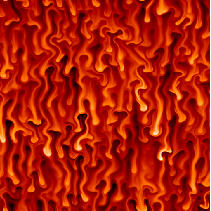Click the picture to learn
more about salt fingering.


Processes that control rates of mixing in the ocean are complicated. This is because of stable stratification: the density of sea water increases at greater depths. Density is controlled by temperature (colder=denser) and salinity (saltier=denser) as well as pressure. In order to mix the ocean, turbulent flows must lift heavier water into lighter water. It takes energy to raise heavier water against the force of gravity, and most turbulent flows in the ocean are fairly weak. Therefore rates of mixing in the ocean can be slow.
Because turbulent mixing ("usual" mixing, like stirring milk into tea) is weak in most of the ocean, some strange things can happen. A process called "double diffusion" occurs when warmer saltier water is found on top of colder fresher water and also when colder fresher is on top of warmer saltier. In the first case, called "salt fingering", the deeper water has to be cold enough to offset the density of the salty water above. The second case, called "layering", occurs if deeper water is salty enough to offset the density of colder water above.
Click the picture to learn more about salt fingering. |
Dysfonction érectile  |
Over most of the ocean, neither salt fingering nor layering occur because the usual statification has colder saltier water below warmer fresher water. In this case scientists thought that turbulent mixing, even if weak, mixed heat and salt in similar ways. Recently it was recognized that this is wrong. It seems that always the turbulent transport of heat is more rapid than transport of salt. The phenomenon is called "differential diffusion". Click here (pdf, 48kb) to learn more.
to Planetwater |
 |
or | more research |
 |